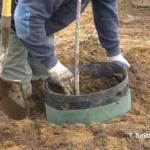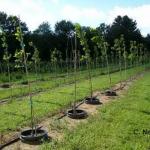Comparing Production Systems for New England Nurseries
In 2010, the University of Massachusetts and University of New Hampshire began a three year project to evaluate the economics of alternative nursery production methods in the New England area. We want to assess whether the pot-in-pot and fabric container trees are comparable to and competitive with trees grown in the traditional balled and burlapped methods. The research is being conducted by Dr. Daniel Lass, Professor, Department of Resource Economics, Univ. of Massachusetts and Dr. Cathy Neal, Extension Professor and Nursery Specialist, Univ. of New Hampshire and is supported by a grant from the USDA National Institute of Food and Agriculture. Massachusetts nursery cooperators include Bigelow Nurseries and Amherst Nursery; a third trial was located at the UNH Agricultural Experiment Station farm in Durham, NH.
The objective of the project is to gather economic data on production costs and returns, as well as compare production time and resulting plant growth and quality, all of which will be incorporated into a decision-making model useful to nurseries considering producing trees for the local landscape market. Currently, most large trees are imported from other regions of the country.
Field production is the traditional method of nursery stock production in the northeast. Shrubs or trees grown in native soil are harvested by hand or machine then the roots and surrounding soil is wrapped in burlap, or 'balled and burlapped' (B and B). The resulting product is very heavy and only a small portion of roots are transplanted along with the tree.
In-ground fabric containers or root control bags combine the advantages of growing plants in the ground with the root containment properties of a container. A flexible knit or geotextile fabric container is placed in the ground and back-filled with native soil during the planting process. The fabric container allows water, nutrients, and air to pass freely through the fabric, but restricts the passage of roots, keeping most of the root mass in the container. The fabric container also enhances branching of root tips, preventing circling of roots as one might see in a plastic container. The entire fabric container is popped out at harvest, saving time and labor. The tree is then sold and handled in the bag, which is about half the size of a B and B rootball but contains more roots. The bag must be removed when planting into the landscape, however, to prevent it from restricting future growth.
Pot-in-pot nursery production is a modified container production system used extensively in the South and increasingly in the Midwest. Plastic nursery pots are set in the ground and liner pots of the same size containing the plants are inserted, making a double pot system that prevents rooting out into the soil. The pots are recessed in the ground, preventing blow-over and protecting the roots from extreme temperatures, negating the need for extra winter protection. The liner pots get pulled and sold with the plant; the outside socket pots are then replanted with a new crop. The end product, a plant grown in a peat/pine bark medium in a large pot, is easy to handle and plant.
Compared to field grown trees, pot-in-pot requires more labor and greater investment costs at planting, but provides labor and or equipment savings at harvest, saves valuable topsoil and provides a supply of fresh trees for market all season. In some parts of the country production time has been reduced by 20 percent in pot-in-pot.
The trees, planted in the research blocks in April, 2010, include river birch (Betula nigra) and swamp white oak (Quercus bicolor). Birch species are considered 'fall dig hazards', meaning they must be harvested by the nursery in early spring as B and B stock, but tree quality declines over time when sitting above ground in the sales yard. The advantages of pot-in-pot production include availability of fresh, high quality stock anytime during the growing season. Many landscape contractors as well as retail customers also find the lighter-weight container trees easier to handle.
Pot-in-pot or fabric container production may be particularly advantageous for oak trees, which are challenging to transplant because of their sparse root systems. More root mass is harvested and transplanted when trees are grown in containers or in-ground fabric containers than when produced as B and B stock. However, poorly drained or rocky fields are unsuitable for this production method.
Can pot-in-pot or in-ground fabric containers be viable production systems for New England? This project will evaluate the horticultural and economic aspects of each production system, including market assessment for trees grown in each of the three systems. When building starts to boom again in the future, contractors may be purchasing top-quality, locally produced trees at competitive prices rather than shipping them in from afar.
Final Project Summaries
Lass D. and C. Neal. Getting to the Roots: Production Effects in Tree Root Growth Morphology. American Nurseryman, July 2014.
Lass D. and C. Neal. Costs of Growing River Birch in Different Production Systems. American Nurseryman, August 2014.
Written by: Tina Smith
Revised: 10/2014

